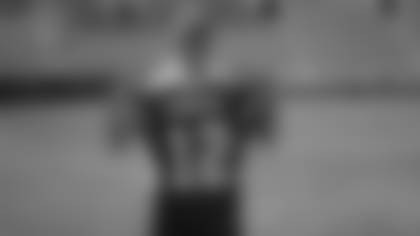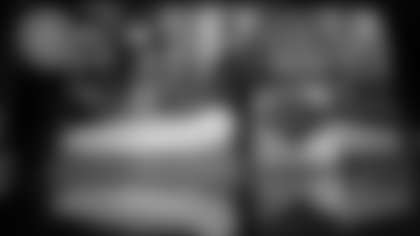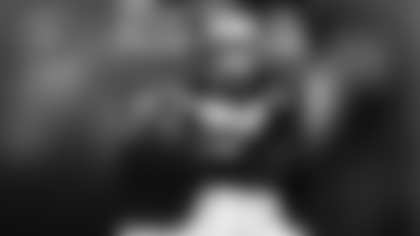Packers team historian Cliff Christl has assembled an oral history series on the NFL Draft, highlighting significant and noteworthy years as a prelude to Green Bay hosting the 2025 draft in late April. New installments will be posted most weekdays. For access to the full series thus far, click here.
1989
The headquarters for the 54th NFL Draft, held April 23-24, 1989, was the Marriott Marquis Hotel in New York City. The first five rounds were conducted the first day, starting at 12:04 p.m. (EDT) and ending at 9:43 p.m. The final seven rounds were completed on the second day, starting at 10 a.m. and ending at 5:17 p.m.
In all, the draft took 16 hours, 56 minutes to complete. It also was the first draft since the merger where underclassmen were eligible.

Fans can now register for free entry to the 2025 NFL Draft by downloading the NFL OnePass app or by registering online!
Were the Packers a no-show for Barry Sanders' workout?
For as much time as vice president of football operations Tom Braatz and others in the Green Bay Packers organization invested in evaluating Tony Mandarich, they failed to do their due diligence with Barry Sanders, another viable option to take with the second overall pick.
One of the Packers' deep, dark secrets of their 24-year famine from 1968 through 1991 was the snafu that occurred on April 12, the day of Sanders' pre-draft workout in Stillwater, Okla.
Jesse Kaye, soon to be hired as a pro scout under Braatz and an administrative assistant under coach Lindy Infante on what he was told about scout Bobo Cegelski's trip to Stillwater (Christl interview, Oct. 27, 2020): "I liked Bobo. He had a way of weaving through a description of a player. He would write things up fairly well. But he had a major flaw that he could only overcome with Tom. It's highly sensitive, but (Cegelski) was supposed to attend Barry Sanders' workout and for some reason he missed it. I don't remember why. … But (Cegelski) never saw it. We got the numbers. That was about it."
Ron Wolf, who would become Packers GM two years later (Email, Oct. 27, 2020): "I heard that but with a little different take. I heard (Cegelski) was late due to the fact that he had his dog with him and had to take care of it."
Packers team president Bob Harlan (Email, Oct. 27, 2020): "I was not aware at the time, but discussed it with someone later on. You could be right. All the scouts talked about was Mandarich."
The 1989 draft turned out to be a roll call of future Pro Football Hall of Famers through the first five picks.
Today, the busts of Troy Aikman, Barry Sanders, Deion Sanders and Derrick Thomas all rest in Canton. Mandarich's career was best summed up by two Sports Illustrated covers: One from April 24, 1989, titled, "The Incredible Bulk: 6'6", 315-Pound Tony Mandarich – The Best Offensive Line Prospect Ever" and the other from Sept. 28, 1992, titled: "The NFL's Incredible Bust."
Back when the woebegone Packers couldn't win for losing, they managed to beat the Phoenix Cardinals on the final weekend of the 1988 season for what was only their fourth victory in 16 games. The cost of it was the No. 1 pick in the draft and a crack at acquiring a potential and desperately needed franchise quarterback.
Nevertheless, shortly after the game ended, Braatz stood in the locker room at Sun Devil Stadium and all but declared that he'd be just as happy with the consolation prize. "If the draft were held today, we'd be taking Mandarich," Braatz stated more than four months before the draft.
Thereafter, the Packers never seriously wavered from that plan.
Braatz said in a 1991 interview and again in 2005 that after Infante learned about Sanders' workout, they revisited the two options: Mandarich or Sanders. But Braatz described those talks as "more a discussion than a debate." And in the end, he said, they mutually agreed on Mandarich.
Plus, unlike the top football people for the teams picking third, fourth and fifth, neither Braatz nor Infante had ever seen Sanders in the flesh.
Clearly, the Packers hadn't taken seriously his late entry into the draft pool, at least until it was too late. By comparison, the teams immediately following them in the order sent their head coaches – Detroit's Wayne Fontes, Kansas City's Marty Schottenheimer and Atlanta's Marion Campbell – to witness Sanders' workout, whereas the Packers assigned the task to a lone college scout.
In fact, the Lions, who owned the third choice, sent a three-man contingent, which also included vice president of finance Chuck Schmidt and college scout Jim Owens.
The workout lasted only 45 minutes and started with Sanders' two unexpected and blazing times in the 40-yard dash. Thus, even if Cegelski was merely late, more than likely he missed the most impressive part of the show.
Interestingly, newspaper coverage of the event was largely limited to what the Associated Press distributed on its wire, and it sent out two different accounts of how many teams were there. One stated there were nine teams represented; the other that there were only eight. The Oklahoma City Oklahoman published the version that specified nine; USA Today wrote eight.
While there were two widely disseminated AP photos of the workout, they weren't conclusive either. One was of Sanders' finishing one of his 40s, and it showed six scouts at the finish line, none of them from the Packers. The other was of Sanders' vertical jump, and it can't be ruled out that one of the observers in the distant background was Cegelski.
Braatz, who was widely respected by members of the media for his honesty, also had a curious way of later explaining in interviews why the Packers revisited the Mandarich-Sanders debate late in the process. He told reporters "that changed after Bobo came back from the workout," rather than saying after Bobo had attended or watched the workout.
If there was no eyewitness there for the Packers, there would have been no way to recapture the moment, either. According to Oklahoma State strength and conditioning coach Rob Glass, who just completed his 29th season at the school and was there that day, nobody shot film of the workout.
What's more, Sanders' times were clocked only by the hand-held stopwatches of the individual coaches and scouts, which meant if the Packers didn't get their own times, they could only trust the word of others.
Glass (Christl interview, Feb. 13, 2025): "I can't recall if the Packers had anyone in attendance, but (the turnout) was pretty light."
Sanders' agent Peter Schaffer, who was there, on whether the Packers were represented (Christl interview, Feb. 21, 2025): "If they were, nobody was paying any attention to them. Tom (Braatz) didn't go because he had made his decision. He was going to take Tony Mandarich. If he sent a lower-level scout, it just showed Tom wasn't taking (Sanders). There were no upper-level Packer people there."

Two transcendent prospects & a potential franchise QB
Well in advance of the draft, scouts were discussing how it might be one of the most top-heavy ever. Based on the final, pre-draft grades of the National Scouting Combine, Mandarich topped the list with a mark of 8.5, the highest since Bo Jackson was given a perfect 9.0 in 1986. Deion Sanders, who ran a 4.29 40-yard dash, got an 8.0.
Aikman's grade was 7.6 but he, too, was included in what scouts were calling "The Big Three" because he was a highly coveted QB. Two linebackers – Derrick Thomas of Alabama and Broderick Thomas of Nebraska – rounded out the top five with grades of 7.7 and 7.6, respectively.
At that point, Barry Sanders had yet to be given a grade.
New York Jets director of player personnel Mike Hickey (Newsday, April 20, 1989): "(Deion) Sanders and Mandarich aren't just blue chips, they're prototypical."
New England director of player personnel Dick Steinberg (Milwaukee Journal, April 16, 1989): "I think Mandarich and Deion Sanders standalone by themselves. They are simply exceptional athletes at their position. Players like that don't come around very often. Aikman is a good quarterback, but I wouldn't put him in that category. Same with Barry Sanders."
New Orleans director of player personnel Bill Kuharich (Milwaukee Journal, April 16, 1989): "It's outstanding at the top. That four will compare well to almost any four."
Individually, scouts saw few flaws in any of them.
On Mandarich (6-6, 315):
Kansas City general manager Carl Peterson (Kansas City Star, April 23, 1989): "He's a guy that comes out once every 10 years. On the offensive side of the ball, I would liken him to (defensive tackle and future Hall of Famer) Randy White. I've never seen a 300-pound man do what he's done and also play football. The way he can jump, run was extraordinary."
Washington general manager Bobby Beathard (Palm Beach Post, April 18, 1989): "He's perhaps the best offensive lineman prospect I've ever seen. He's so good it's almost like he's not real."
New York Giants director of player personnel Tom Boisture (Sports Illustrated, April 24, 1989): "Anthony Munoz is the measuring stick for all offensive linemen coming out, and this kid is better."
Buffalo director of college scouting John Butler (Milwaukee Journal, April 16, 1989): "Mandarich is in a class by himself. Everyone likes to compare him to Bill Fralic (second overall pick in 1985). But Fralic could never run like that. No lineman can run like Mandarich. He wears an 'S' on his chest."
On Deion Sanders (5-11, 187):
Beathard (Tampa Tribune, April 21, 1989): "He could be one of the best cornerbacks ever to come into the game. He is an exceptional player. You could put him over at wide receiver and he'd be one of the top guys there, too. They say he is two people: Prime Time and Deion. The only thing that can hurt Deion is Prime Time."
Hickey (USA Today, April 22, 1989): "He's better than (future Hall of Famer) Mike Haynes was when he came out. I was at New England when Haynes was drafted (fifth overall in 1976)."
New Orleans Saints general manager Jim Finks (Arizona Republic, April 22, 1989): "Sure, I'd be concerned about him choosing baseball. He has a couple of qualities baseball teams love. He can run down balls. He can steal bases. He could be like (St. Louis Cardinals outfielder) Vince Coleman. These days kids like to be challenged. Bo Jackson has shown that."
Florida State junior safety and teammate LeRoy Butler (Palm Beach Post, Jan. 1, 1989): "He has feet like O.J. Simpson, the instincts of Mike Singletary. He's faster than Bo Jackson. He has the vision of Jack Tatum and the hands of Larry Bird. I watch him and then I ask: 'How can one player be so good?"
On Aikman (6-2½, 220):
Denver director of player personnel Reed Johnson (Fort Lauderdale Sun Sentinel, April 17, 1989): "He's the closest thing to John Elway to come out of the draft. He can run for first downs. He's tall. He's fast. He's strong. He's smart enough. He wins. He controls the game. He's got that look in his eyes. He's got dodge-ability. He's run the wishbone. If you don't have one of these guys today, you're going to have a hard time winning."
Detroit director of player personnel Joe Bushofsky (Milwaukee Journal, April 16, 1989): "He's one of those guys who comes around but once every 10 years."
Steinberg (Dallas Morning News, April 16, 1989): "There's nobody close to him. He's a very, very smart guy with a great arm and very rugged build. But he has surprisingly quick feet. Coming out of college, comparing him to Elway, he is under Elway slightly in every category. But the whole package is there."
Boisture (Dallas Morning News, April 16, 1989): "Mentally, he's kind of like (Bob) Griese. This guy is aware. He is an intelligent kid. We're not talking about a rock."
On Derrick Thomas (6-2½, 2225):
Butler (USA Today, April 20, 1989): "Derrick Thomas can literally take over a game. Great ability to burst off a block, can change directions, run with anybody. You didn't see him much in pass coverage, but in the Senior Bowl he did that a couple of times and ended up picking one off."
Dallas vice president of personnel development Gil Brandt (Tampa Tribune, April 20, 1989): "(Derrick) was a very dominating player at the University of Alabama. He has size, speed, athletic ability and everything you need to be an outstanding linebacker in the NFL."
Peterson (USA Today, April 20, 1989): "They're both (Derrick and Broderick) very talented guys. Derrick is more of a pure linebacker type, who can drop into coverages, can play the run and can blitz. We worked Broderick out about a week ago. He weighed 267 pounds, and he can run, but he's more, I think, of a designated pass rusher type. He has not had that much experience in pass drops."

Awestruck scouts couldn't believe their eyes
After Barry Sanders wowed coaches and scouts alike during his workout on the artificial turf at Oklahoma State's Lewis Field, Detroit's vice president for personnel Jerry Vainisi declared, "It definitely makes the 'Big Three,' the 'Big Four.'"
Sanders held his workout only eight days after NFL Commissioner Pete Rozelle ruled him eligible for the draft. As a true junior, Sanders was previously ineligible because of the rules at the time, but his attorney, David Ware, threatened to sue the league if his petition to enter the draft wasn't granted.
Sanders had won the Heisman Trophy with a record-setting rushing total, but he was 5-foot-8 and 203 pounds with what was estimated to be 4.5 speed at best. Because he was a junior, Sanders hadn't been timed by combine scouts nor had he appeared in a nationally televised game. He was viewed as a likely first-round pick but also too short and slow to be a high No. 1.
Then Sanders shocked scouts on both of his 40-yard dashes: running a 4.39 on the first try and following it up with a 4.43, running in the opposite direction against a slight wind.
Next, in the vertical jump, from a standing, flat-footed position, Sanders skied 41½ inches. His distance in the standing broad jump was 10 feet, 11 inches. He ended his workout by running some simple routes and catching passes thrown by an assistant coach.
It was the sub-4.4 40 times – which varied on the different watches – and his two vertical jumps that were jaw-dropping.
Fontes (Associated Press, April 13, 1989): "If the draft was today, I'd take Barry Sanders. He's a player that would help our team the quickest and help us get into the end zone the quickest. Every time he would do something, all the other coaches and scouts were looking our direction and I just looked back as if to say, 'No chance guys.' This is our guy, a rare player that comes along just once in a while."
Campbell on Sanders (Atlanta Journal-Atlanta Constitution, April 16, 1989): "He's got it all. He can catch. He can run. I know people talk about his size, but that won't be a problem for him. When we tested him on the standing jump, I thought the guy was never going to stop going up."
Schaffer (Christl interview, Feb. 21, 2025): "My memory was Wayne Fontes. Barry runs 4.37, Fontes takes out a cigar, lights it up and says, 'I've seen enough.'"
A little less than two months earlier, Mandarich had left scouts in near disbelief with his mind-boggling side show to Michigan State's pro day. In Mandarich's case, he merely solidified his standing as the top-graded player in the draft.
He was clocked at 4.65 in the 40-yard dash, bench-pressed 225 pounds an astonishing 39 times and was credited with a vertical jump of 30 inches and a standing broad jump of 10 feet, 3 inches.
Charlie Davis, Packers offensive line coach from 1988-91 (Lansing State Journal, Feb. 18, 1989): "When he ran that 40, everyone put his watch against his chest. No one wanted to say his time first, in case it was wrong."
Kansas City scout Whitey Dovell (Lansing State Journal, Feb. 18, 1989): "I've been around football 38 years, and I've never seen anyone like him."
Jim Erkenbeck, Dallas offensive line coach from 1987-88 (Lansing State Journal, Feb. 18, 1989): "What he did today was impressive – really impressive! Someday, we'll be able to tell people we were here when this happened."
The SI article titled "The Incredible Bulk," reported that the Michigan State coaches had created special categories just for Mandarich when they graded film during the season, including "pancakes," when he flattened an opponent; "off the film," when he drove an opponent out of the camera's view; and "no mas," when defenders simply quit against him.
Mandarich's "pancake" totals included 10 against both Ohio State and Wisconsin, and seven against Purdue.
George Perles, Michigan State head coach and former Pittsburgh assistant coach when it won four Super Bowls (Sports Illustrated, April 24, 1989): "As a junior, (Mandarich) could have started on any of our Super Bowl teams. He may be the best offensive tackle ever. He's certainly the best since the game changed the blocking rules (in the 1970s). … He's faster than any offensive lineman in pro football. There's probably nobody faster in the world at his weight. This is a different player. We'll never have another."
Draft day: The first five choices fall as predicted
Coming off a 3-13 finish, their worst since they went 0-11-1 in 1960 as an expansion franchise, the Cowboys, along with owning the No. 1 pick, also were experiencing what was the most turbulent offseason in their 30-year history.
In late February, news broke that H.R. "Bum" Bright had agreed to sell the Cowboys to Arkansas oilman Jerry Jones. While it took until April 18 – only five days before the draft – for NFL owners to officially approve the sale, Jones had already fired Tom Landry by then and revealed that Jimmy Johnson would replace him.
In addition, the handwriting was on the wall that team president Tex Schramm would be out of a job, as well. Eight days after the draft, Brandt, longtime personnel director and the third member of the Cowboys' triumvirate since their birth, was also given his walking papers.
Knowing that they had almost two months to prepare for the draft while the sale was pending, Jones and Johnson didn't waste time getting started. And soon thereafter, Jones said Aikman would be their pick, as long as he lowered his asking price. In Texas, writers suspected that Jones and Johnson were being coy about their plans, strictly as a negotiating ploy.
Jones (Fort Worth Star-Telegram, Feb. 26, 1989): "There is no player that Jimmy Johnson feels greater about than Troy Aikman."
Jones (Associated Press, March 3, 1989): "If Aikman gets his price right … he'll be a Cowboy. He can be the Roger Staubach of the 1990s. He's got to do some cutting on his price. We're not going to pay that kid a lot of money. If not, we'll go with (Steve) Walsh (Johnson's quarterback at Miami)."
Johnson (AP, March 3, 1989): "You have to have a winning quarterback. I think Steve Walsh is a winning quarterback. He's not a great talent, but he's a winner."
Jones (Fort Worth Star-Telegram, April 19, 1999): "We decided early that to trade down would be a mistake. When you've got the No. 1 pick, you can't go anywhere but down. … We feel that Troy Aikman will make a great Cowboy."
Meanwhile, not everybody in the Packers organization was blind to Mandarich's potential shortcomings. Davis, their offensive line coach, admitted on draft day that Mandarich had done little pass blocking in college. "That's one of his weaknesses, only because he doesn't have a lot of experience," Davis told the Milwaukee Journal.
Weeks before that, Burt Gustafson also sounded an alarm. After serving the Packers in a number of roles for nearly 20 years under four coaches, Gustafson was frustrated because Braatz wouldn't listen to him, as he put it, and was about to retire. Again, Gustafson's advice fell on deaf ears.
Gustafson (Christl interview, Jan. 7, 2014): "Mandarich was Tom Braatz's boy. Braatz didn't like me from the get-go and I didn't like him. I went in and told him, 'Tom, I've looked at some film on Mandarich. I saw him in the Iowa game, and this guy can't play in the NFL.' 'Why? 'He couldn't block a 6-foot-3, (200 some pound) kid playing defensive right end for Iowa. He couldn't pass block him. You're going to have to do a lot of coaching to get him to be a pro player.' Then I walked out of the room. (Mandarich) didn't have the feet. I think he wore a 10 or 11 shoe. Guys his size wore 13, 14s."
The Iowa-Michigan State game was played Oct. 1, 1988, and ended in a 10-10 tie. Mandarich started for the first time that season after being suspended for three games and was matched up for most of it against sophomore Jim Johnson, who was making just his fourth collegiate start. Johnson registered seven tackles, two for losses, despite being outweighed by 50 pounds.
But reality is that almost every other team in the league would have made the same mistake as the Packers had they held the No. 2 choice.
Indianapolis director of operations Bill Tobin (Chicago Tribune, April 20, 1994): "Everybody had Mandarich graded high. Unfortunately, the Packers took the fall."
At the time, the Packers' assistant coaches were heavily involved in the draft process and had just spent three weeks on the road looking at the top prospects at their positions. However, backfield coach Willie Peete not only didn't attend Sanders' workout, but he also expressed reservations about him fitting into Infante's offense.
Peete (Fond du Lac Reporter, April 13, 1989): "Sure, if you ran an I-formation, you might want guys like Sanders and Tim Worley (the other top-ranked running back) so you could just line them up and give them the ball and let them run with it. But we don't do that. The halfbacks on our roster have to be more than just ball carriers. They have to be able to block, they have to be able to split out wide and they have to be able to catch the ball. At this point Sanders is kind of hard to evaluate because he just decided to come out. It's hard to tell if he's the kind of running back we need."
Plus, Peete explained that Brent Fullwood, who was drafted fourth overall by the Packers in 1987, fit their offense only as a featured runner from the fullback position. That ruled out a Sanders-Fullwood backfield combination. "(Fullwood) is a fullback in this system – running between the tackles," said Peete. "At halfback he'd have to learn how to split out as a wide receiver."
There was yet another issue with both of the Sanders. Neither Barry nor Deion wanted to play for the Packers.
Deion Sanders, when asked if he'd play in Green Bay (Fort Myers News-Press, Dec. 16, 1988): "I don't want to turn in my alligator shoes for snow boots or my Mercedes for a bobsled. I won't go."
William Sanders, Barry's father (Washington Post, April 1, 1989): "No way in the world he's playing in Green Bay. He's just not. Would you go to work in Green Bay? They don't pay any money in Green Bay and there's no marketplace there."
As a result, once the Packers completed their investigation into the widespread reports that steroids had at least something to do with Mandarich's freakish test results, there was little chance of Braatz changing his mind and the pick was his call.
Braatz (Tampa Tribune, April 18, 1989): "Our trainer talked to the (Michigan State) trainer. Our doctor talked to the (Michigan State) doctor. I talked to (coach) George Perles. Tony Mandarich took the physical in Indianapolis. Our information is good. For the last two years, (Mandarich) has not been on (steroids)."
After the Packers submitted Mandarich's name, Fontes got his wish.
Fontes (Detroit Free Press, April 24, 1989): "I told you people we were going to restore the roar. (Sanders) will electrify the crowd. We're gonna put the ball in his hands. … This guy is going to win some games for us."
Schaffer (Christl interview, Feb. 21, 2025): "I never had any sense (Barry Sanders) was going anywhere but Detroit."
The aftermath of the Mandarich pick
Mandarich held out over a contract dispute for 44 days before his rookie season and played sparingly.
He passed a drug test when he reported the week before the opener, but team physician Eugene Brusky immediately noticed telltale signs of anabolic steroid use, including hair loss and excessive pimples around his shoulders and back. Maybe even more alarming, Mandarich's weight was down 18 pounds or more and he looked passive in practice.
Brusky (Christl interview: Dec. 10, 2002): "Sure, there were signs (of steroid use). It was his demeanor. It took away his enthusiasm, his aggressiveness. It's like any other drug. You stop it and the body, which had been making its own testosterone, has quit making it. The body quits making it because he is taking it externally. So when the body quits making it, it takes a long time to start realizing, 'Whoop, we don't have enough testosterone here,' and then for the hormones to begin to form again. That goes with any drug."
In his 2009 book, "My Dirty Little Secrets: Steroids, Alcohol & God," Mandarich finally admitted to abusing steroids during his years at Michigan State but said he stopped using them around the time of the draft out of fear of flunking the NFL drug test.
Soon after, he said he resorted to mainlining painkillers and mixing them with growth hormone. Alcohol became yet another craving, and his life starting spiraling out of control.
After playing sparingly as a rookie, Mandarich started the next two seasons at right tackle. His play was mediocre at best. In 1992, a concussion and recently diagnosed thyroid condition ended his career in Green Bay. After sitting out four seasons, Mandarich made a comeback with Indianapolis in 1996 and was no better than an adequate starter.
Mandarich (Edmonton Journal, Aug. 26, 2015): "The painkiller abuse, and the alcohol abuse, was the main reason for the failure in Green Bay. Every single day, for the four years I was in Green Bay, there was not a sober day."















